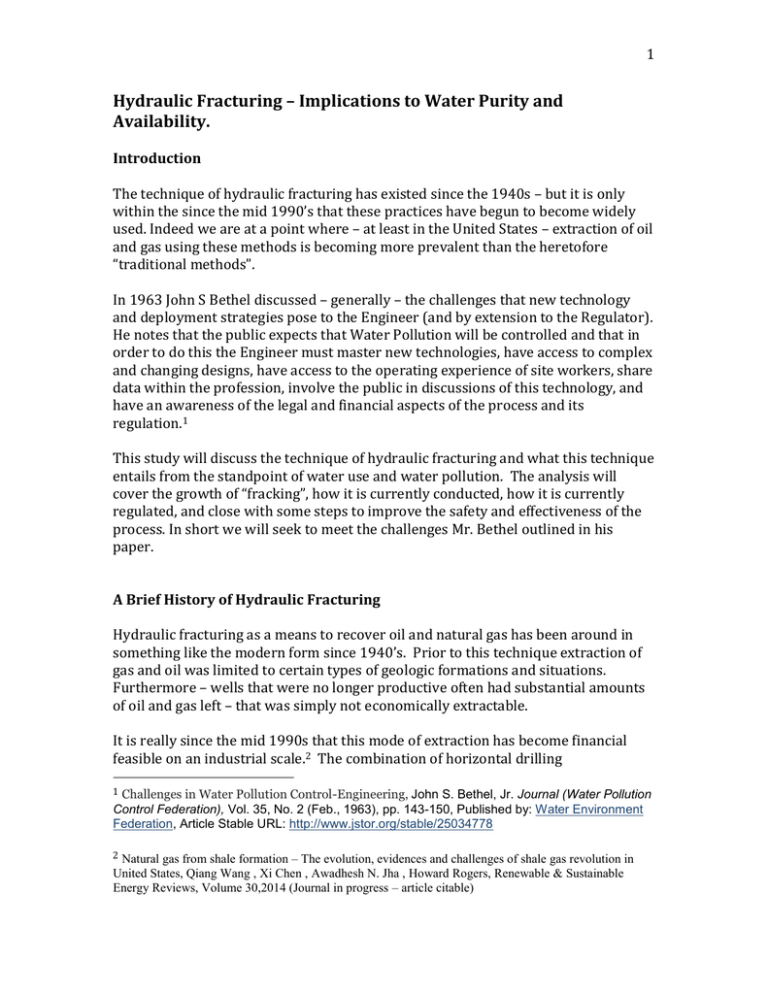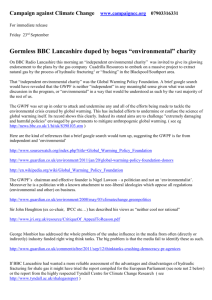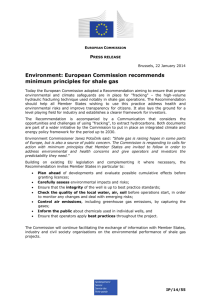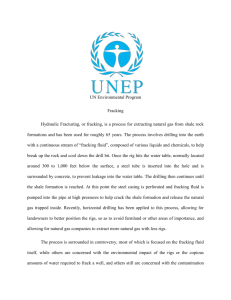Hydraulic Fracturing – Implications to Water Purity and Availability.
advertisement

1 Hydraulic Fracturing – Implications to Water Purity and Availability. Introduction The technique of hydraulic fracturing has existed since the 1940s – but it is only within the since the mid 1990’s that these practices have begun to become widely used. Indeed we are at a point where – at least in the United States – extraction of oil and gas using these methods is becoming more prevalent than the heretofore “traditional methods”. In 1963 John S Bethel discussed – generally – the challenges that new technology and deployment strategies pose to the Engineer (and by extension to the Regulator). He notes that the public expects that Water Pollution will be controlled and that in order to do this the Engineer must master new technologies, have access to complex and changing designs, have access to the operating experience of site workers, share data within the profession, involve the public in discussions of this technology, and have an awareness of the legal and financial aspects of the process and its regulation.1 This study will discuss the technique of hydraulic fracturing and what this technique entails from the standpoint of water use and water pollution. The analysis will cover the growth of “fracking”, how it is currently conducted, how it is currently regulated, and close with some steps to improve the safety and effectiveness of the process. In short we will seek to meet the challenges Mr. Bethel outlined in his paper. A Brief History of Hydraulic Fracturing Hydraulic fracturing as a means to recover oil and natural gas has been around in something like the modern form since 1940’s. Prior to this technique extraction of gas and oil was limited to certain types of geologic formations and situations. Furthermore – wells that were no longer productive often had substantial amounts of oil and gas left – that was simply not economically extractable. It is really since the mid 1990s that this mode of extraction has become financial feasible on an industrial scale.2 The combination of horizontal drilling 1 Challenges in Water Pollution Control-Engineering, John S. Bethel, Jr. Journal (Water Pollution Control Federation), Vol. 35, No. 2 (Feb., 1963), pp. 143-150, Published by: Water Environment Federation, Article Stable URL: http://www.jstor.org/stable/25034778 2 Natural gas from shale formation – The evolution, evidences and challenges of shale gas revolution in United States, Qiang Wang , Xi Chen , Awadhesh N. Jha , Howard Rogers, Renewable & Sustainable Energy Reviews, Volume 30,2014 (Journal in progress – article citable) 2 breakthroughs (largely attributable to the Mitchell Drilling Company), hydraulic fracturing, and higher prices for oil and gas, combined to allow industrial level extraction to occur. The graphic below3 illustrates the technique: The success of this combination of techniques has given rise to an astounding growth in gas (as well as oil) produced by this method. The graphic below displays the growth from 20004 3 4 Natural Gas From Shale Formation -page 3 Natural Gas From Shale Formation –page 7 3 This surge in production has many well-documented benefits – greater energy independence, economic growth, employment, and competitiveness in manufacturing among them. But this paradigm shift is precisely the sort of event that Bethel wrote about in his article. Water Pollution Challenges It is worth noting that environmental issues connected to hydraulic fracturing are not confined to Water. Seismic activity associated with fracking is documented and certainly concerning. It may contribute to Water issues if for instance there is hydraulic fracturing occurring near water conduits – but we won’t treat it in this discussion. This concern is one reason that New York State has been cautious about permitting fracking in the Marcellus shale. Likewise there are large releases of gases into the atmosphere as a result of fracking. These releases may be accidental – as in the case of wells that “blow out” – or less dramatic – as methane and natural gas that escapes from the fracking fluid, which returns to the surface as “produced water”. These challenges are definitely worth discussion – but are beyond the intended scope of this research. Donald Rumsfeld’s famous comment – “ there are known knowns, known unknowns, and unknown unknowns” is quite pertinent in discussing water issues associated with fracking. Water Consumption A known – known is that hydraulic fracturing consumes large amounts of water. The water consumption can continue even after a well is drilled because hydraulic fracturing may be done several times in order to extract gas and oil from the same well. The EPA reports that: 4 “It was estimated that 35,000 wells were fractured in 2006 alone across the US (Halliburton, 2008). Assuming that the majority of these wells are horizontal wells, the annual national water requirement may range from 70 to 140 billion gallons. This is equivalent to the total amount of water withdrawn from drinking water resources each year in roughly 40 to 80 cities with a population of 50,000 or about one to two cities of 2.5 million people 5“ This amount of water consumption is significant for several reasons: 1) It will directly compete for water with other uses – and in some jurisdictions may overwhelm existing rivers, waterways, and aquifers. 2) The withdrawal of this amount of water will exacerbate other water pollution issues – thus for example natural remediation of pollution from other sources – which relies in some measure on dilution – will be impaired. 3) The sheer volume of water – and the means by which is carried to and from the sites almost guarantees that there will be water pollution issues – the water is generally trucked to the site – and may require 40 tanker trucks of water. With this number of trips x 35,000 wells we are almost assured of spills and accidents. Surface Storage of Produced Water The largest known issue is the contamination of surface water and shallow ground water from water that is “produced” when the fracking fluid returns to the surface (typically about 50% of the water returns). This water is polluted with all the chemicals used in the fracking process as well as pollutants that it acquires by contact with geological chemicals (e.g. – radioactive ions and heavy metals). The EPA has compiled a list that extends over 24 pages of the chemicals that are in various fracking fluids (not every chemical is in every fracking fluid).6 Pollution from the injection process Fracking fluid is injected under high pressure. If the well is not properly sealed this fluid can easily escape and be dispersed into existing aquifers. This is definitely an issue in the early days of fracking. Behavior of fluid in geologic formations – natural and under pressure. This is perhaps the key known unknown. Timothy Eaton in the article quoted below makes the point that there is growing evidence that the deep underground and the 5 http://water.epa.gov/type/groundwater/uic/class2/hydraulicfracturing/upload/hf_study_plan_110 211_final_508.pdf page 21 6 http://water.epa.gov/type/groundwater/uic/class2/hydraulicfracturing/upload/hf_study_plan_110 211_final_508.pdf page 119 - 143 5 shallower underground (where our aquifers are typically located) are more connected than we may know. ‘Although conventional hydro geologic analyses assume extremely slow flow rates through these rocks based on equivalent porous medium assumptions (ICF International, 2009), more sophisticated detailed studies (e.g., Runkel et al., 2006) show that even non-karstic sedimentary rocks (sandstone and shale) contain significant brittle fractures, which allow faster preferential flow paths along bedding- planes over distances of kilometers. While solute transport is typically slower than pressurized gas flow in such fractures, both are highly unpredictable and essentially undetectable, barring major events. The limited flow between deep and shallow formations that has already been shown using isotope tracers (Warner et al., 2012) can be locally enhanced by interconnection of existing preferential flow paths by well drilling and hydro fracturing, which destabilize existing hydraulic gradients by changing pressure regimes.”7 Unknown Unknowns While enormous progress has been made in the extraction of gas and oil – the understanding of what the consequences of this sort of activity are – is only beginning to be researched. Per Bethel – research into this area needs to be vigorously pursued. Regulation – or perhaps more precisely – the lack thereof It is natural to expect (per Bethel) that regulation would lag behind in a field like hydro-fracking. What might surprise Bethel is the fact that at least some of the growth of fracking was enabled by the suspension of existing environmental regulations. Eaton summarizes the regulatory scene succinctly: “There are numerous exemptions and limitations in federal environmental legislation and US EPA authority to regulate unconventional natural gas drilling (Wiseman, 2012; US GAO, 2012). Of the eight major pieces of legislation (Safe Drinking Water Act — SDWA; Clean Water Act — CWA; Clean Air Act — CAA; Resource Conservation and Recovery Act — RCRA; Comprehensive Environmental Response, Compensation and Liability Act — CERCLA; Emergency Planning and Community Right-to-Know Act — EPCRA; Toxic Substances Control Act — TSCA; and Federal Insecticide, Fungicide and Rodenticide Act — FIFRA), the first six have important exemptions related to oil and natural gas development. The most important exemptions to these laws were created by the 2005 Energy Policy Act, by which hydraulic fracturing is specifically exempted from regulation under the SDWA Underground Injection Control program, except if diesel fuel is injected… “8 7 Science-based decision-making on complex issues: Marcellus shale gas hydrofracking and New York City water supply, Timothy T. Eaton, Science of the Total Environment 461–462 (2013) 158–169, pg 162 8 Science-based decision-making on complex issues: Marcellus shale gas hydrofracking and New York City water supply, Timothy T. Eaton, Science of the Total Environment 461–462 (2013) 158–169, pg 164 6 State regulation is – as one would expect – extremely variable – with New York basically prohibiting the technique, Texas encouraging it – and very loosely regulating it – and with Pennsylvania regulating it very carefully. Part of the rationale for lack of Federal regulation is based on the fact that typically any single well falls below size requirements. However as has been discussed above – in the aggregate the amount of fluid produced, injected, and discarded is enormous. One way to offset the large water requirements for hydraulic fracturing is to recycle the flowback or produced water in the fracturing process [279,280]. The produced water may be treated and reused by adding additional chemicals as well as fresh Logical Next Steps The status quo discussed in this study depicts a burgeoning new technology, which has produced enormous financial benefits. But it has done so in a barely regulated environment, in the face of environmental challenges, and with growing public distrust of the process. The popular documentary “GASLAND” is typical of what the general public’s view of fracking involves. As noted above New York State has placed a moratorium on fracking of the Marcellus shale. Partially this is the due to the fact that the shale underlies the water supply for New York City but part of it also emanates from a general distrust of the process and the players. Setting aside public perception and regulation for a moment – a key challenge to the process is obtaining sufficient water. Recycling “produced” water would be a great first step in minimizing Water issues. The second “logical step” is to develop Federal regulation that protects the environment and encourages good behavior without unduly restricting production of oil and gas. Recycling Produced Water The challenge of recycling produced water lies in the sheer diversity of chemicals present in produced water. “There are, however, challenges associated with reusing flow back due to the high concentrations of total dissolved solids (TDS) and other dissolved constituents found in flow back [281]. Constituents such as specific cations (e.g., calcium, magnesium, iron, barium, and strontium) and anions (e.g., chloride, bicarbonate, phosphate, and sulfate) can interfere with hydraulic fracturing fluid performance by producing scale or by interfering with chemical additives in the fluids [282]. “9 9 Natural Gas From Shale Formation -page 17 7 That it is difficult is undeniable – but give the regulatory climate and the newness of the technology implementation – it is not surprising that it hasn’t been pursued more successful. There are numerous studies on going and some are yielding good results. The chart below shows in 1000s of barrels a day the amount of produced water in the world (primarily the US)10 In an article entitled “Review of technologies for oil and gas produced water treatment” the authors outline steps that can lower the required water for fracking such as careful transport of the water and making sure that the well is properly sealed – in fracking as in mundane plumbing leaks are an expensive problem. Because of the complexity of the fracking solution the authors recognized that treatment would be multistage and involve physical, chemical, and biological methods. At a high level they set out the goals for water reclamations as: 1. De-oiling: removing dispersed oil and grease, Review of technologies for oil and gas produced water treatment, Fakhru’l-Razi AhmadunAlireza Pendashteh, Luqman Chuah Abdullah, Dayang Radiah Awang Biak, Sayed Siavash Madaeni, Zurina Zainal Abidin, Journal of Hazardous Materials 170 (2009) 530–551, page 532 10 8 2. Soluble organics removal, 3. Disinfection, 4. SS removal: removing of suspended particles and sand, 5. Dissolved gas removal: removing light hydrocarbon gases car bon dioxide, and hydrogen sulfide, 6. Desalination: removing dissolved salts, 7. Softening: removing excess water hardness, 8. Miscellaneous: removing NORM11. The list of processes under consideration is extensive. Reviewing the list of approaches one can certainly feel confident that remediation is very technically possible and that finding the right recipe to follow – will be a matter of much future research. One area that the authors call out is research into membrane technology. Membranes are effective at capturing pollutants – but are quickly fouled by the chemicals in solution. Techniques to clean the pores of the membranes and produce membranes that are strong enough to handle such recycling is an important area of research. Development of Suitable Regulation State regulation is important because of the different nature of each state. But it cannot be the mainstay of regulation- for the simple reasons that the underground resources cross multiple state lines, the water ways likewise flow from state to state, and the externalities that emanate from the process may or may not be confined to a particular state. In an article entitled: Toward strategic management of shale gas development: Regional, collective impacts on water resources the authors outline a framework for regulation that encompasses the regional and dispersed nature of the fracking phenomenon. The key elements of that framework (summarized and paraphrased) are: 1) The framework must be regional and cumulative as opposed to “project” based. As discussed above there are numerous wells underway – and arguably no one well is going to rise to the level that say an offshore drilling 11 Review of technologies for oil and gas produced water treatment, Fakhru’l-Razi AhmadunAlireza Pendashteh, Luqman Chuah Abdullah, Dayang Radiah Awang Biak, Sayed Siavash Madaeni, Zurina Zainal Abidin, Journal of Hazardous Materials 170 (2009) 530–551, page 535 9 platform or coal mine might - but taken in the aggregate they would be on the same or larger scale.12 2) Is flexible enough to consider probabilistic events – the authors argue that given the complexity and novelty of this technology – as well as its dispersed footprint regulation must not just look at what happens – but also at what can happen. These events would be the known unknowns and the unknown unknowns. Concretely this tenet would encourage: a. Ongoing and active site testing b. A go-slow approach to allow uncertainty to manifest before going full speeds ahead. c. A review of impacts under various circumstances – so for instance examining the impact of numerous fracking wells in a drought situation. 3) Encouraging “best practices” and regional management. Simply stated today’s low regulatory climate allows many externalities to remain outside the economic framework. Proper regulation would encourage these externalities to be avoided, treated, or minimized. Conclusion Bethel’s framework for dealing with the challenges of new technology is valuable as we consider the burgeoning challenges that stem from fracking. This study outlines the pace of the change that is occurring and the nature of the technical challenges that face the engineer, the regulator, and indeed the general public. There is evidence of intensive study for ways to deal with complex, widely dispersed, and evolving nature of fracking waste products. We have highlighted that caution is generally appropriate given the novelty of the technology and the speed of adoption. The known problems, the known unknown problems are daunting enough – but true consideration needs to be accorded to the unknown unknowns. 12 Toward strategic management of shale gas development: Regional, collective impacts on water resources, Brian G. Rahm *, Susan J. Riha New York State Water Resources Institute, Department of Earth & Atmospheric Sciences, Cornell University, 1123 Bradfield Hall, Ithaca, NY, USA page 14 10 Regulation is finally stirring and it would appear that the Federal Government is at last becoming more active. A brief discussion of regulation outlined the requirements for broad and regional regulation that recognizes that the state of knowledge is incomplete and thus regulation needs both vigilance and flexibility. Finally – public opinion – and level of public knowledge are key components of any public policy surrounding fracking. Trust by the public needs to be earned and hopefully a thoughtful approach such as has been outlined would contribute to earning that trust.





